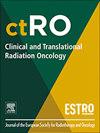放疗在转移性直肠癌治疗中的作用:对非手术治疗和器官保存的机会的叙述回顾
IF 2.7
3区 医学
Q3 ONCOLOGY
引用次数: 0
摘要
约20%的直肠癌患者存在转移性直肠癌(MRC)。MRC患者的5年相对生存率约为15%。随着系统性治疗的出现,包括更有效的化疗方案、免疫治疗、靶向治疗和局部选择放疗,越来越多的晚期直肠癌患者在原发肿瘤中获得完全的临床缓解。因此,通过“观察和等待方法”的非手术管理(NOM)越来越受欢迎。此外,改进的生物标志物,如循环肿瘤DNA (ctDNA),可以提高预测新辅助放化疗反应的准确性,并在达到完全临床反应后监测复发。在这篇叙述性综述中,我们研究了目前放疗在MRC治疗中的作用的证据,重点是NOM和器官保存策略。值得注意的是,尽管一些调查已经评估了NOM方法的各个方面,但关于患者满意度和生活质量的数据仍然有限。生活质量的改善可能是推动患者对NOM偏好的关键因素,我们也强调了NOM对患者生活质量影响的数据。本文章由计算机程序翻译,如有差异,请以英文原文为准。

The role of radiotherapy in the management of metastatic rectal cancer: A narrative review on the opportunities for non-operative management and organ preservation
About 20% of patients with rectal cancer present with metastatic rectal cancer (MRC). The 5-year relative survival for patients with MRC is about 15%. With emerging systemic therapies, including more effective chemotherapy regimens, immunotherapy, targeted therapies, and radiotherapy as a local option, more patients with advanced rectal cancer are achieving complete clinical response in the primary tumor. Consequently, non-operative management (NOM) through a “watch and wait approach” is becoming increasingly desired. Additionally, improved biomarkers, such as circulating tumor DNA (ctDNA), can improve accuracy in predicting responses to neoadjuvant chemoradiotherapy and monitoring recurrence after achieving complete clinical response. In this narrative review, we examine the current evidence on the role of radiotherapy in the management of MRC, with a focus on NOM and organ preservation strategies. Notably, although several investigations have evaluated various aspects of the NOM approach, there is still limited data regarding patient satisfaction and quality of life. The improved quality of life may be a key factor driving patient preference for NOM, and we also emphasize the data on the impact of NOM on patient’s quality of life.
求助全文
通过发布文献求助,成功后即可免费获取论文全文。
去求助
来源期刊

Clinical and Translational Radiation Oncology
Medicine-Radiology, Nuclear Medicine and Imaging
CiteScore
5.30
自引率
3.20%
发文量
114
审稿时长
40 days
 求助内容:
求助内容: 应助结果提醒方式:
应助结果提醒方式:


